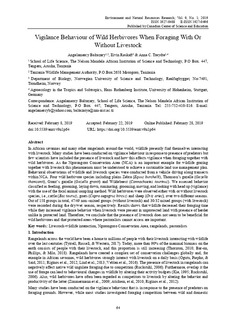| dc.description.abstract | In African savannas, and many other rangelands around the world, wildlife presently find themselves interacting with livestock. Many studies have been conducted on vigilance behaviour in response to presence of predators on foraging grounds, but few scientists have included the presence of livestock and how this affects vigilance when foraging together with wild herbivores. As Ngorongoro Conservation Area (NCA) is an important example of wildlife grazing together with livestock, this phenomenon must be understood to achieve a sustainable land use management plan, particularly in Ngorongoro Conservation Area and in other protected areas. Behavioral observations of wildlife and livestock species were conducted from a vehicle driving along transects within NCA. Once a group was sighted the vehicle was stopped and sighting information recorded. Four species of wild herbivores including plains zebra (Equus burchelli), Thomson’s gazelle (Gazella thomsonii), Grant’s gazelle (Gazella granti) and Wildebeest (Connochaetes taurinus) were studied together with the following livestock species including cattle (Bos taurus), goats (Capra aegagrus hircus) and sheep (Ovis aries), in different seasons. 158 groups were recorded. In dry season 47 non –mixed groups (without livestock) and 30 mixed groups (with livestock) were recorded, while, during wet season 49 non -mixed groups and 32 mixed groups were recorded. Behavior was classified as feeding, grooming, laying down, ruminating, grooming, moving, and looking with head up (vigilance) with the use of the focal animal sampling method. Wildlife decreased their foraging time while they increased vigilance behavior when livestock were present; however, more studies are still for a wider conclusion. | nb_NO |

